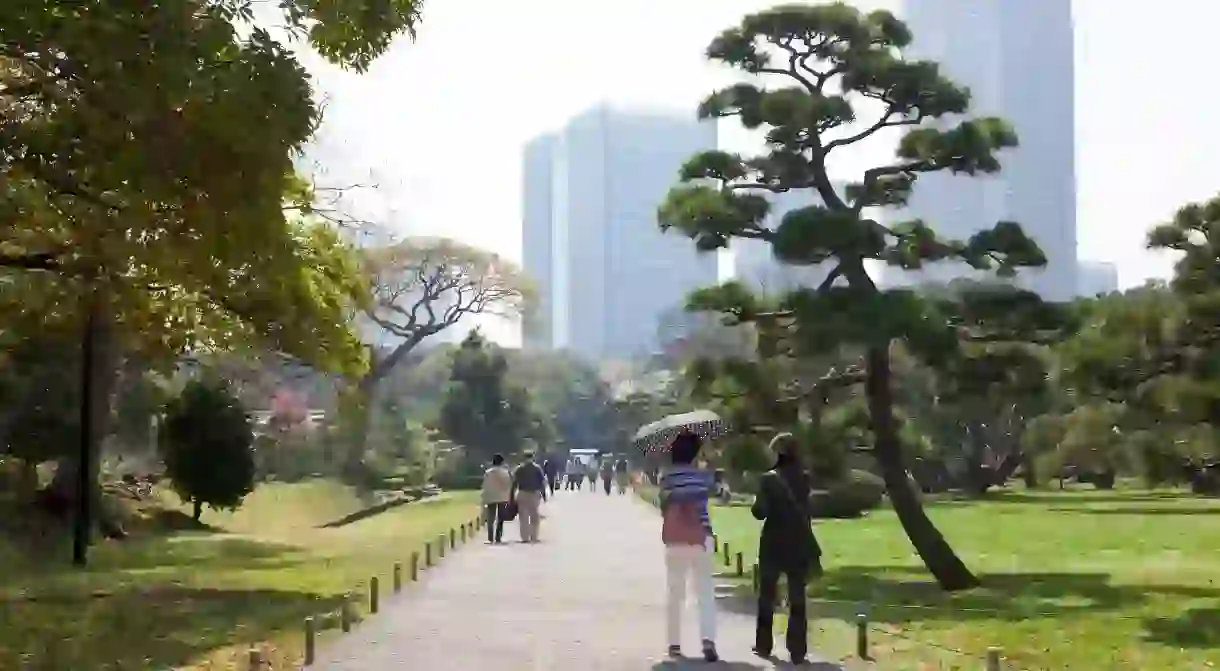Top Things to Do in Ginza, Tokyo

The busy shopping and entertainment district of Ginza is relatively small in size, but offers plenty to see and do. From luxury boutiques and ritzy cocktail and sushi bars to the famous Chuo-dori shopping promenade and traditional Japanese dance and drama at the landmark Kabuki-za theatre, here’s how to get the most out of a trip to the area.
The site of a former coin mint (ginza means ‘silver mint’ in Japanese), Tokyo’s central Ginza district has been an upmarket shopping destination since its reconstruction following the Great Kantō earthquake of 1923. Today, visitors can enjoy the best of Japanese culture, fashion and style on its charming streets.
Shop till you drop on the Chuo-dori
One of Tokyo’s most exclusive and affluent neighbourhoods, Ginza is a shopper’s paradise. Start at the Chuo-dori, Ginza’s main shopping area. Running north to south through the centre of the district, the street becomes a pedestrianised promenade at the weekends, and is completely closed to traffic every weekend from 12pm to 5pm (until 6pm from April to September).
Don’t miss the old-fashioned clock tower sitting atop Ginza Wako, one of the area’s most iconic department stores. Situated on a corner halfway down the Chuo-dori, the retailer offers luxury goods such as watches, jewellery and cosmetics. Like many other shops in Tokyo, the shopping is tax-free for foreign visitors, so don’t forget to bring your passport.
Other places worth a visit on the Chuo-dori include Ginza Six, a stylish and architecturally impressive building and the neighbourhood’s largest department store, with some 241 shops under one roof. Further up the street are Mitsukoshi and Matsuya, two of Japan’s most famous department chain stores. It’s also worth checking out Itoya, the legendary stationary store with 12 floors of home, school and office goods you didn’t realise you needed in your life.
Don’t limit yourself to shopping on the Chuo-dori, however – the various sidestreets have lots to offer, too. The Tokyu Plaza Ginza on Nishiginza-dori street is yet another swanky department store with a great open rooftop offering sweeping views of the city. Many of the big Western brands have flagship stores in the neighbourhood, including Burberry, Chanel, Uniqlo and the 10-storey Bulgari Ginza tower, home to the largest Bulgari store in the world.

Get lost inside Ginza’s showrooms
Directly across the street from Ginza Wako is Ginza Place, an intriguing white-lattice fronted building full of event spaces, exhibitions and restaurants. Tech enthusiasts will want to check out the Nissan and Sony showrooms; at Nissan Crossing you can see the latest cars up close, while Sony showcase their cutting-edge devices here. The restaurants and bars on the upper floors offer great views of the always-bustling Ginza intersection.

Stand to attention at the Police Museum
At the northern end of Ginza is the quirky Police Museum. Run by the Tokyo Metropolitan Police Department and free to enter, it contains an assortment of police-related paraphernalia. Although there isn’t much in the way of English-language information, it’s still worth a look, with a range of uniforms and police vehicles on display.

Enjoy a night of kabuki
On the east side of Ginza is the famous Kabuki-za Theatre, a faithful reconstruction of the original building which was constructed here in 1889. It is the principle place to watch kabuki, a classical-style dance drama, in Tokyo. Tickets for the daily performances range from 2,000 to 20,000 yen (US$18–$180). Even if the language is mostly impenetrable to non-Japanese speakers, Kabuki performances are lively and colourful and feature traditional Japanese music.

Delve into a world of Japanese art
Ginza used to be a meeting place for arty types back in the day, and some of that legacy remains with the various art galleries dotted around the neighbourhood, many of which are free to enter. Gallery Shukado showcases a wide variety of Japanese paintings, antiques and ukiyo-e (traditional woodblock prints), while the Pola Museum Annex has an ever-changing lineup of art exhibits. Perhaps most intriguing is the Okuno Building, an apartment block dating back to the 1930s that is like a work of art in itself; inside there are a number of small art galleries on every floor.

Find a moment of peace in the Hamarikyu Gardens
For a complete change of scenery and to escape the crowds, spend an hour or so at the far southern end of Ginza in the beautiful Hama Rikyu Gardens. Overlooking Tokyo Bay, these carefully sculpted gardens were originally built for a feudal lord in the Edo Period, and are a wonderful place to stroll, whatever the season.

Indulge in world-class food and drink
In the evening, head back into central Ginza to sample some of the high-class dining the area is famous for. There are plenty of deluxe restaurants to choose from, including Michelin-star sushi at the world-famous Sukiyabashi Jiro (booked up months in advance), award-winning yakitori (grilled chicken on skewers) at Birdland Ginza and French-Japanese fusion at Esquisse.
As the sun begins to set, well-dressed folk will create a trail to Ginza’s most exclusive cocktail and wine bars, where some of Tokyo’s best trained bartenders carefully craft drinks to the individual tastes of their customers. Bar High Five, Star Bar Ginza and Y&M Kisling are all highly rated.
If you don’t want to blow your entire eating and drinking budget in one single evening, then check out the restaurants built into the arches under the tracks north and south of Yūrakuchō Station. There, you can find an assortment of yakitori stands, gritty izakayas (Japanese-style pubs serving food and drink), beer bars and a few slightly more upmarket wine bars.














